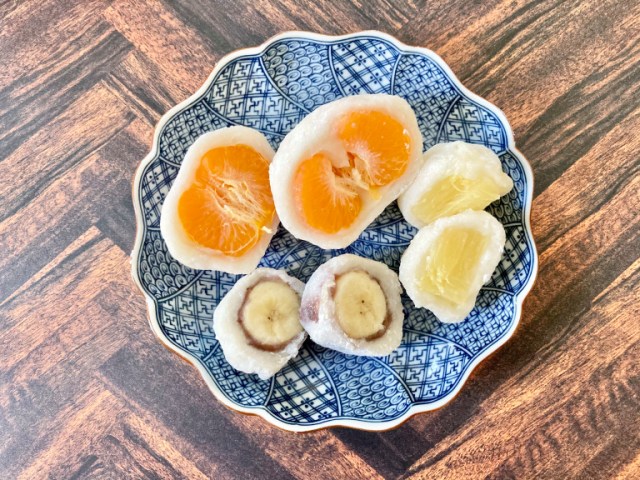
Today in the SoraKitchen we’re mixing nature’s candy with Japanese sweets.
Mochi comes in a lot of different forms, but just about everyone agrees that one of the best is daifuku. These sweet dumplings aren’t just delicious, they’re versatile too, and as proof today we’re going to make three different types of fruit daifuku that look and taste great.
For our dessert project, we used a make-it-yourself daifuku kit (available here) from Suehiroan, a traditional Japanese confectioner whose original shop is in Kawasaki. You can get pretty much everything that’s in the kit at just about any Japanese market, though.
The kit contains:
● Mochi sheets
● Powdered mochi
● Koshi an (sweet red bean paste)
● Shiro an (sweet white bean paste)
● Cooking oil
● A kiriito (cutting string)
One of the most common fruit daifuku fillings is strawberries, but since they’re out of season right now, we decided to go with banana, orange, and pineapple.
▼ Yes, canned pineapples aren’t necessarily “in season” either, but we were really, really craving pineapple.
Daifuku are meant to be eaten in about two bites, so you’ll want to slice your fruit accordingly. Once you’ve done that, the next step is to coat each piece with sweet bean paste.
We opted for red bean paste for the banana and white for the orange and pineapple. One thing to keep in mind is that if the surface of the fruit is damp, the bean paste will have a tough time sticking to it, so if you’re using canned fruit, you’ll want to remove any excess syrup before you start applying the coating.
Next, you’re going to want to dab a bit of oil and powdered mochi on your fingertips. That’s because it’s time to wrap the bean paste-covered fruit in mochi, and pre-treating your fingertips will keep the mochi from sticking to your hands. Cut off a piece of mochi, knead it for a bit, and then wrap it around the fruit.
This can be a little tricky, because mochi is sticky, sometimes stubborn stuff. Keep at it, though, an eventually you’ll have a plate of fruit daifuku!
Technically, these are ready to eat right here. Depending on your commitment to presentation, though (something that Japanese confectioners pride themselves on), there’s one more thing to do. Since the fruit is a full 50 percent of what makes fruit daifuku so delicious, let’s cut each dumpling in half.
▼ We used our kit’s kiriito, but a sharp knife should do the trick too.
Not only does this give the diner a sneak-peak at the flavor they can expect, the frosty white of the outer mochi layer creates for a nice contrast with the filling, making the fruit’s cross-section look mouthwateringly vivid in color.
And of course, as always, the best accompaniment to Japanese sweets is a fresh cup of green tea.
In terms of flavor, all three of our fruit daifuku tasted great, but we were especially satisfied with the banana ones. They’re definitely going on the list for the next batch we make, but since you can make fruit daifuku with any kind of fruit, we’re looking forward to continuing our experimenting too.
Photos ©SoraNews24
● Want to hear about SoraNews24’s latest articles as soon as they’re published? Follow us on Facebook and Twitter!
[ Read in Japanese ]